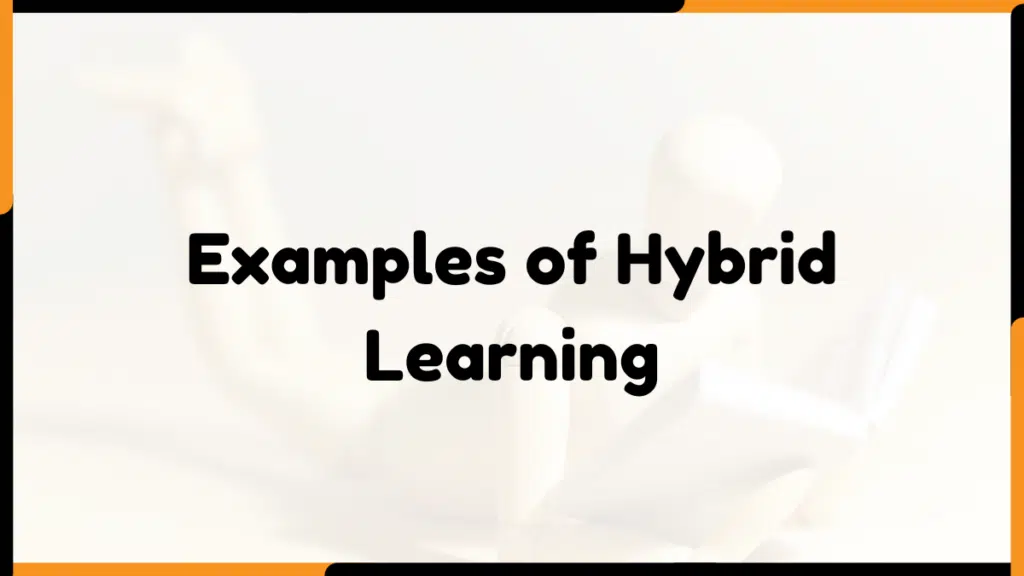20 Examples of Hybrid Learning
Hybrid learning, often referred to as blended learning, has become a prominent educational approach that combines traditional in-person instruction with online resources and activities.
This flexible learning model has gained momentum in recent years, offering students and educators the best of both worlds.
In this blog post, we’ll explore 20 examples of hybrid learning that showcase its versatility and effectiveness in diverse educational settings.

Examples of Hybrid Learning
1: Flipped Classroom
In a flipped classroom, students first learn content online, typically through video lectures, and then engage in face-to-face discussions and activities to deepen their understanding.
2: Online Discussion Forums
Hybrid learning incorporates online discussion forums to facilitate collaborative learning, allowing students to discuss and reflect on course materials.
3: Simulations
Hybrid learning can incorporate interactive online simulations that provide students with hands-on learning experiences, especially in subjects like science and engineering.
4: LMS (Learning Management Systems)
Using Learning Management Systems like Canvas or Blackboard, educators can manage resources, assignments, and communication, creating a seamless learning experience.
5: Webinars
Hybrid learning often utilizes webinars to bring experts and guest speakers into the virtual classroom, enhancing the learning experience with real-world insights.
6: Virtual Labs
Science and technology courses can leverage virtual labs, allowing students to perform experiments and analyze results in an online environment.
7: Peer Assessment
Students can assess each other’s work online, promoting peer learning and critical thinking skills.
8: Hybrid Textbooks
Some textbooks are now available with online interactive components that supplement the print version, providing a richer learning experience.
9: Adaptive Learning Platforms
Adaptive learning software tailors content to individual students’ needs, ensuring that they receive personalized instruction and support.
10: Video Lectures
Recorded video lectures allow students to revisit class content at their own pace, providing flexibility and support for different learning styles.
11: Social Media Integration
Educators can incorporate social media into hybrid learning to foster discussions, share resources, and connect with students.
12: Project-Based Learning
Hybrid learning can include collaborative, project-based assignments that encourage critical thinking and problem-solving skills.
13: Hybrid Assessments
Combining traditional exams with online quizzes, essays, and peer evaluations can provide a comprehensive assessment of student learning.
14: Gamification
Gamified elements, such as leaderboards and badges, make learning more engaging and fun in a hybrid setting.
15: Virtual Field Trips
Hybrid learning allows students to explore far-off places and cultural experiences through virtual field trips, enhancing their understanding of the world.
16: Interactive Whiteboards
Interactive whiteboards in physical classrooms enable teachers to integrate digital resources during in-person sessions.
17: Online Tutorials
Students can access online tutorials and resources to support their learning outside of regular class hours.
18: Hybrid Language Courses
Language learners benefit from a blend of online language exercises and face-to-face conversations with native speakers.
19: Hybrid Professional Development
Educators themselves can engage in hybrid learning for professional development, attending webinars and workshops while maintaining their teaching responsibilities.
20: Synchronous and Asynchronous Learning
Hybrid learning combines synchronous sessions (real-time interaction) with asynchronous elements (self-paced study), accommodating different student schedules and preferences.
Hybrid learning is a dynamic approach that offers countless possibilities for enhancing education.
These 20 examples showcase the adaptability of hybrid learning across various subjects and levels of education.
As technology continues to evolve, so too will the potential for hybrid learning, making it an exciting and effective tool for educators and learners alike.



Leave a Reply